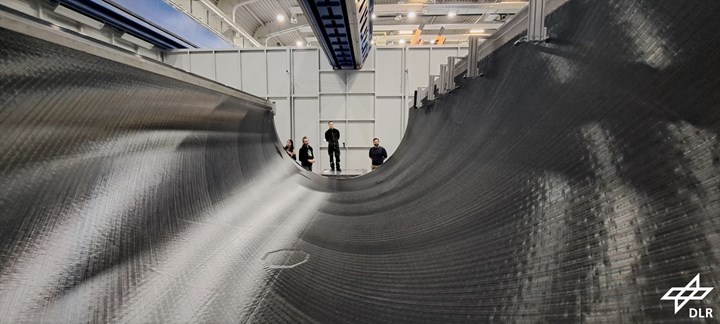DLR completes MFFD upper shell skin layup
Eight-meter-long CFRTP fuselage skin was achieved via laser-heated in-situ consolidation, with stringers, frames and cleats to be welded.
In Jan. 2023, the DLR Institute of Structures and Design (DLR, Augsburg, Germany) completed the layup of the full-scale, 8-meter-long fuselage skin for the Multifunctional Fuselage Demonstrator’s (MFFD) upper shell.
Funded by Clean Aviation, the welded MFFD fuselage demonstrator is said to represent the largest known aeronautical structure made of thermoplastic composites. Begun in 2014, project partners Airbus (Toulouse, France), Aernnova Aerospace (Miñano, Spain) and Premium AEROTEC (Augsburg, Germany) seek to demonstrate significant weight reduction, while cutting back waste and cost (see “Moving forward on the Multifunctional Fuselage Demonstrator (MFFD)”).
The upper shell skin was made using Toray Advanced Composites (Nijverdal, Netherlands) Cetex TC1225 carbon fiber thermoplastic prepreg made using low-melt polyaryletherketone (LMPAEK) from Victrex (Clevelys, U.K.). The prepreg tape was placed on a TC1225 LSP film which was impregnated with the same LMPAEK matrix. An LDM diode laser provided by Laserline GmbH (Mülheim-Kärlich, Germany) and the multi-tow laying head from AFPT GmbH (Dörth), performed laser-heated in-situ consolidation to achieve a smooth skin on the upper shell’s Grunewald GmbH & Co. KG (Bocholt) placement tool. (Watch this video for a visual of the MFFD upper shell production).
“Our placement end-effector with three parallel ½-inch tows has a theoretical throughput of about 4.4 kilograms/hour which corresponds to a production time of 32 hours,” Dominik Deden, senior expert on thermoplastic AFP at DLR, says. “For an industrialized production the number of parallel tows would be increased to meet the goal of 100 aircraft per month. In general, in-situ consolidation avoids vacuum bagging and all related tasks which otherwise can account for up to 40% of the lead time for panel production.”
Production of the test shell was originally completed in April 2022 with the integration of the upper shell’s sixth frame. Moving forward, stringers delivered by Aernnova Aerospace will be integrated via continuous ultrasonic welding, and frames and cleats delivered by Premium AEROTEC will be resistance welded. Read “Thermoplastic composites welding advances for more sustainable airframes” for additional details on what comes next for the upper shell skin.
Related Content
-
Combining multifunctional thermoplastic composites, additive manufacturing for next-gen airframe structures
The DOMMINIO project combines AFP with 3D printed gyroid cores, embedded SHM sensors and smart materials for induction-driven disassembly of parts at end of life.
-
Sulapac introduces Sulapac Flow 1.7 to replace PLA, ABS and PP in FDM, FGF
Available as filament and granules for extrusion, new wood composite matches properties yet is compostable, eliminates microplastics and reduces carbon footprint.
-
Recycling end-of-life composite parts: New methods, markets
From infrastructure solutions to consumer products, Polish recycler Anmet and Netherlands-based researchers are developing new methods for repurposing wind turbine blades and other composite parts.

















